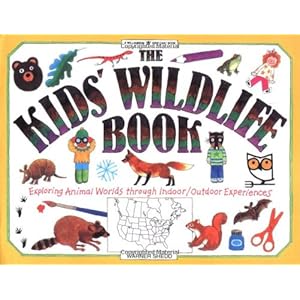Looking for ways to incorporate more science into
your summer camp, after school program, or classroom?
I recently pulled a book called The Kids’ Wildlife Book, by Warner Shedd, off the USEE teacher resource shelves and found some really neat
activities.
The book teaches kids about 21 different animals, their characteristics,
adaptations, and other cool facts all through hands-on activities. Below are some easy-to-do home, summer
camp, or classroom ideas to explore this summer.
Quill Necklaces
Did you know Native Americans used porcupine quills as jewelry?
Have your students use round toothpicks to make a design and glue them to a piece
of cardboard. Cut the extra cardboard off around the quills. Paint them with different colors and add string to make your own
necklace. Don’t forget to look up some Native American designs to get inspired!
Nut Hunt
Pretend you're a squirrel who is burying food for the
winter. Do you think you can remember or use your sense of smell (or
observation) to find where you hid your food? Use about 20 nuts (or small
toys/balls etc) and bury them in different places outside. Wait two days and go
back and find them. Could you find all 20?
Playing Opossum
This fun game is a variation of a freeze dance. When opossums are threatened, they play
dead to try to trick a predator into leaving them alone. In this game, one
person is a coyote and everyone else is an opossum. The coyote turns on some
music and everyone moves and dances about. When the coyote stops the music,
everyone must freeze. The coyote then walks around trying to make the opossums
laugh, smile, move, etc. If an opossum moves, he or she is out. Last person standing
is the new coyote.
Raccoon Egg Snatch
Raccoons are sneaky, intelligent mammals who have learned a
trick or two about finding food. Some have learned to follow the tracks of
biologists who check bird nesting boxes to snatch their eggs. In this game, one
person is a biologist and has a ball or bean bag for the "egg." The biologist
places the egg right behind his or her own feet, and the raccoons stand behind a starting
line about 10-15 feet away. The object is for the raccoons to steal the egg
from the biologist without being caught. As the biologist counts to three, the raccoons sneak up
to steal the egg. On three, the biologist turns around, and anyone caught moving
goes back to the starting line.
Radar Game
Bats, dolphins, and other animals use echolocation to find
food and move around. Pretend you are a bat in this variation of tag, and try to
find your friends by listening only for their squeaks. This is best played in a large
open area free of trip hazards. The tagger is blindfolded and all the other “bats”
must make squeaking sounds like a bat. The squeaking bats can’t move and must
make noises from the start of the game until they are tagged. The tagger
listens for the bat squeaks in order to find his or her playmates and tag them out.
Last person tagged is the new tagger.
The Kid's Wildlife Book has many more cool and fun activities, including art ideas, games, experiments, and cool facts that
will make learning about animals fun for any age group in any educational
setting.
If you are a teacher, come by the USEE office to check out this
book and our whole teacher resource center. If you live too far away, try your local library.
Honestly, I think I’m going to buy this book for my own
collection. I like it that much.
-Holly


No comments:
Post a Comment